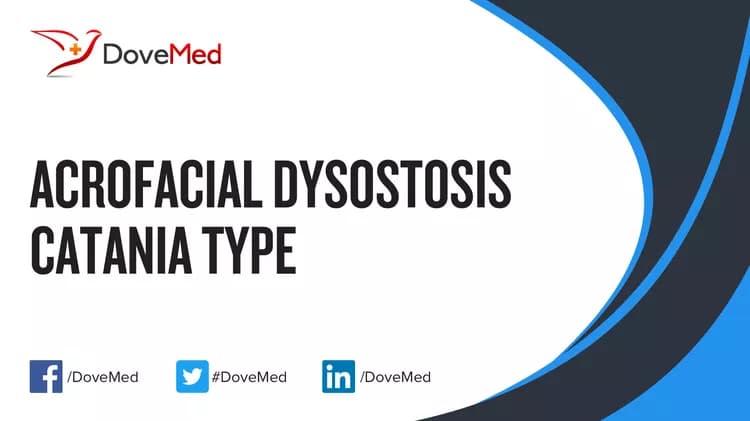What are the other Names for this Condition? (Also known as/Synonyms)
- AFD, Catania type
- Catania type of Acrofacial Dysostosis
- Opitz-Mollica-Sorge Syndrome
What is Acrofacial Dysostosis, Catania type? (Definition/Background Information)
- Acrofacial Dysostosis, Catania type is a very rare type of acrofacial dysostosis (AFD)
- It is characterized by mild intrauterine growth retardation (IUGR), postnatal short stature, microcephaly, widow's peak, and mandibulofacial dysostosis without cleft palate
- Also, frequent caries, mild pre- and post- axial limb hypoplasia with brachydactyly, mild interdigital webbing, simian creases, inguinal hernia and cryptorchidism and hypospadias in males, are noted
(Source: Acrofacial Dysostosis, Catania type; Orphanet, National Institute of Health and Medical Research (INSERM), Paris.)
Who gets Acrofacial Dysostosis, Catania type? (Age and Sex Distribution)
- Acrofacial Dysostosis, Catania type is a rare congenital disorder. The presentation of symptoms may occur at birth
- Both males and females may be affected
- Worldwide, individuals of all racial and ethnic groups may be affected
What are the Risk Factors for Acrofacial Dysostosis, Catania type? (Predisposing Factors)
- Currently, no risk factors have been clearly identified for Acrofacial Dysostosis, Catania type
It is important to note that having a risk factor does not mean that one will get the condition. A risk factor increases one’s chances of getting a condition compared to an individual without the risk factors. Some risk factors are more important than others.
Also, not having a risk factor does not mean that an individual will not get the condition. It is always important to discuss the effect of risk factors with your healthcare provider.
What are the Causes of Acrofacial Dysostosis, Catania type? (Etiology)
Presently, the exact cause of development of Acrofacial Dysostosis, Catania type is unknown.
What are the Signs and Symptoms of Acrofacial Dysostosis, Catania type?
The signs and symptoms of Acrofacial Dysostosis, Catania type may include:
- Widow's peak
- Single transverse palmar crease
Very frequently present symptoms in 80-99% of the cases:
- Abnormality of the palate
- Brachydactyly
- Carious teeth
- Downslanted palpebral fissures
- Finger syndactyly
- High forehead
- Hypoplasia of the zygomatic bone
- Intellectual disability, mild
- Microcephaly
- Microretrognathia
- Short nose
- Short palm
- Small hand
- Smooth philtrum
Frequently present symptoms in 30-79% of the cases:
- Abnormal hair pattern
- Bilateral single transverse palmar creases
- Cryptorchidism
- Delayed skeletal maturation
- Feeding difficulties in infancy
- Intrauterine growth retardation
- Low-set, posteriorly rotated ears
- Preauricular pit
Occasionally present symptoms in 5-29% of the cases:
- Clinodactyly of the 5th finger
- Coarse hair
- Facial cleft
- Hypospadias
- Inguinal hernia
- Pectus excavatum
- Premature birth
- Reduced number of teeth
- Spina bifida occulta
- Webbed neck
(Source: Acrofacial Dysostosis, Catania Type; Genetic and Rare Diseases Information Center (GARD) of National Center for Advancing Translational Sciences (NCATS), USA.)
How is Acrofacial Dysostosis, Catania type Diagnosed?
Acrofacial Dysostosis, Catania type is diagnosed on the basis of the following information:
- Complete physical examination
- Thorough medical history evaluation
- Assessment of signs and symptoms
- Laboratory tests
- Imaging studies
- Biopsy studies, if necessary
Many clinical conditions may have similar signs and symptoms. Your healthcare provider may perform additional tests to rule out other clinical conditions to arrive at a definitive diagnosis.
What are the possible Complications of Acrofacial Dysostosis, Catania type?
The complications of Acrofacial Dysostosis, Catania type may include:
- Facial deformities
- Infertility
- Decreased quality of life
Complications may occur with or without treatment, and in some cases, due to treatment also.
How is Acrofacial Dysostosis, Catania type Treated?
There is no cure for Acrofacial Dysostosis, Catania type. The treatment is usually given to manage the signs and symptoms and any complications that develops.
How can Acrofacial Dysostosis, Catania type be Prevented?
- Currently, Acrofacial Dysostosis, Catania type may not be preventable, since the cause of this disorder is unknown
- Regular medical screening at periodic intervals with tests and physical examinations are recommended
What is the Prognosis of Acrofacial Dysostosis, Catania type? (Outcomes/Resolutions)
- The prognosis of Acrofacial Dysostosis, Catania type is dependent upon the severity of the signs and symptoms and associated complications, if any
- Individuals with mild conditions have better prognosis than those with severe symptoms and complications
- Typically, the prognosis may be assessed on a case-by-case basis
Additional and Relevant Useful Information for Acrofacial Dysostosis, Catania type:
Acrofacial Dysostosis, Catania type is also known by the following names:
- ACD (Acrofacial Dysostosis, Catania type)
- Catania form of AFD
The following DoveMed website link is a useful resource for additional information:
Related Articles
Test Your Knowledge
Asked by users
Related Centers
Related Specialties
Related Physicians
Related Procedures
Related Resources
Join DoveHubs
and connect with fellow professionals


0 Comments
Please log in to post a comment.